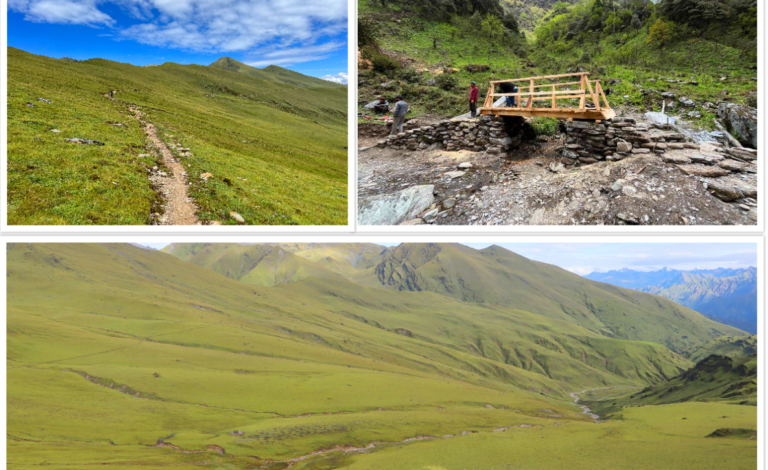Once a hidden gem nestled in the remote landscape of Dhorpatan, Buki Patan was relatively unknown just five years ago. Known for its breathtaking natural beauty, the area remained out of reach for many due to its narrow, treacherous trails used mostly by herders and livestock. Today, however, the scene has changed dramatically, with a growing influx of both domestic and international tourists.
From Isolation to Attraction
For years, Buki Patan remained isolated from mainstream tourism due to its poor accessibility. The route to the highland was narrow, slippery, and often dangerous, suitable only for herders and their animals. Only a handful of adventurous travelers made the trip occasionally.
However, things began to shift significantly in the past year. Since last tourism season, Buki Patan has seen a noticeable surge in visitor numbers. Its serene meadows, panoramic Himalayan views, and peaceful environment have quickly placed it on the travel radar of nature lovers and trekkers alike.
Infrastructure Development Drives Change
Recognizing the potential of Buki Patan as a promising tourist destination, the Gandaki Provincial Government allocated NPR 2 million in the current fiscal year to develop necessary infrastructure. The funds were utilized to construct rest stops, wooden bridges, and a 5-kilometer trekking trail linking Dhorpatan Valley to Garpacheda, which lies close to Buki Patan.
With the development of the trail, what was once a hazardous and tiring journey is now safer and more enjoyable. According to Paras Singh Thapa, Chief of the Office of Tourism and Industry in Baglung, the trail was constructed under the supervision of a local consumer committee and was completed in the first week of Ashadh (mid-June), having started in Chaitra (March).
“Previously, tourists used to fall and get injured while navigating the slippery trail,” said Thapa. “Now, with the new path in place, some sections paved and others left natural, visitors can travel safely. We’ve also added wooden bridges at three spots and three designated rest points to enhance the trekking experience.”
Tourism Activity Surges in Monsoon Season
Traditionally, Buki Patan was mainly occupied by herders during the rainy season, as they brought thousands of sheep, goats, and cattle to graze in the open pastures. During winter, the area remained deserted due to snow and cold temperatures.
Now, the growing popularity of Buki Patan has begun to shift seasonal patterns, as tourists continue to visit even during monsoon. Local hotel entrepreneur Jeevan Adai noted that most tourists coming to Dhorpatan now make Buki Patan a part of their itinerary. He added that the increase in visitors has inspired locals to start ‘Goth-stay’ (herder hut lodging) facilities at Garpacheda, offering tourists a unique experience of highland culture and lifestyle.
“Where there used to be only herders and livestock, we now see tourists taking pictures, camping, and enjoying local hospitality,” said Adai. “Earlier, the trail was so narrow that animals and herders would frequently fall. Now that the trekking trail is in place, such risks have been greatly minimized.”
Locals See Hope in Sustainable Tourism
With improved access and rising interest, tourism in Buki Patan is now viewed as an opportunity for local economic development. The area, which sits at an altitude of approximately 4,500 meters above sea level, is surrounded by scenic spots such as Tikadhar, Phagune, and Garpacheda, all of which are also gaining popularity among trekkers.
Til Bahadur Pun, a local from Dhorpatan, confirmed that tourist footfall has increased in nearby sites too. “These regions are now becoming part of multi-day treks and eco-tourism packages. Tourists are exploring not just Buki Patan, but the surrounding highland meadows and ridges,” he said.
Trekking Experience Made Safer and More Enjoyable
The newly built path, stretching from Pakathar to Garpacheda, provides an alternative to the earlier hazardous route. It not only reduces travel time but also enhances safety, making the experience accessible even for less experienced hikers.
The route now includes wooden bridges over streams, and scenic resting spots where travelers can pause, enjoy the view, and acclimatize. While some portions of the trail are built using stones and concrete for durability, others retain a natural surface to preserve the environment’s rustic charm.
Buki Patan’s Growing Appeal
The meadow of Buki Patan, with its rolling grasslands and distant Himalayan peaks, is becoming a peaceful escape for urban dwellers and nature lovers alike. Visitors often report being enchanted by the quietness of the highlands, the gentle sounds of grazing livestock, and the traditional lifestyle of the herders.
As infrastructure improves and word spreads, Buki Patan is well on its way to becoming a leading eco-tourism destination in western Nepal. The balance of natural beauty, cultural authenticity, and newfound accessibility offers a compelling reason for more tourists to include this once-hidden highland on their travel bucket list.
Looking Ahead
With the success of this year’s improvements, local stakeholders are hopeful that future investments will include amenities like eco-lodges, signboards, and guided trekking services. There is also growing interest in hosting cultural events and seasonal festivals that celebrate the traditional herding culture of the region.
For now, Buki Patan stands as a model of how small-scale, community-based infrastructure development can lead to big changes, transforming a remote grazing ground into a thriving tourist destination while preserving its natural and cultural heritage.






